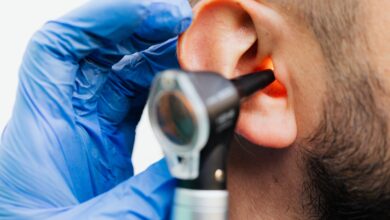
Vitiligo is a skin condition characterized by the appearance of white patches on the skin.
Where do these white spots come from? What are the causes of this disease?
All the answers to your questions can be found in this sheet.
Vitiligo, what is it?
Vitiligo is a skin condition characterized by the appearance of white spots on the feet, hands, face, lips or any other part of the body. These spots are caused by “depigmentation”, ie the disappearance of melanocytes, the cells responsible for the color of the skin (pigmentation).
The depigmentation can be more or less important, and the white spots, of variable sizes. In some cases, the hair or hair that grows inside the depigmented areas is also white. Vitiligo is neither contagious nor painful, but it can cause significant psychological distress.
Vitiligo is a disease whose symptoms are mainly aesthetically embarrassing, the spots not being painful or directly dangerous to health. Consequently, vitiligo is often “minimized” and is still insufficiently treated by doctors. However, it is a disease that has a very negative impact on the quality of life of those affected, as confirmed by a study . People with dark skin are particularly affected.
Types of vitiligo
There are several types of vitiligo :
Segmental vitiligo
Localized on only one side of the body, for example on part of the face, upper body, leg or arm. This form of vitiligo appears more often in children or adolescents. The depigmented area corresponds to a “territory of innervation”, that is to say an area of the skin innervated by a particular nerve. This form appears rapidly over a few months, then usually ceases to evolve.
generalized vitiligo
It presents in the form of spots that are often more or less symmetrical, affecting both sides of the body, in particular areas of repeated friction or pressure. The term “widespread” does not necessarily mean that the spots are extensive. The evolution is unpredictable, the spots being able to remain small and localized or to spread quickly.
vitiligo universalis
Rarer, it spreads rapidly and can affect almost the entire body.
Vitiligo: who is affected?
Vitiligo affects approximately 1% to 2% of the population. It generally appears around the age of 10 to 30 (half of those affected are affected before the age of 20).
Vitiligo is therefore quite rare in children. It affects both men and women, and occurs all over the world, on all skin types.
The causes of vitiligo
The causes of vitiligo are not well known. However, we know that the appearance of white spots is due to the destruction of melanocytes, the skin cells that produce melanin.
Once the melanocytes are destroyed, the skin becomes completely white. Several hypotheses are now put forward to explain the destruction of melanocytes . Vitiligo is probably a disease that has both genetic, environmental and autoimmune origins.
Autoimmune hypothesis
Vitiligo is a disease with a strong autoimmune component. Indeed, people with vitiligo produce abnormal antibodies that directly attack melanocytes and help destroy them. Moreover, vitiligo is often associated with other autoimmune diseases, such as thyroid disorders, which suggests the existence of common mechanisms.
Genetic hypothesis
Vitiligo is also linked to genetic factors, not all of which have been clearly identified . It is common for several people to have vitiligo in the same family. At least 10 genes are involved, as shown in a study in 201024. These genes play a role in the immune response.
accumulation of free radicals
According to several studies , the melanocytes of people with vitiligo accumulate many free radicals, which are forms of waste produced naturally by the body. This abnormal accumulation would lead to a “self-destruction” of the melanocytes.
Nervous hypothesis
Segmental vitiligo results in depigmentation of a delimited area, corresponding to the area innervated by a given nerve. For this reason, researchers have thought that the depigmentation could be linked to the release of chemical compounds from the ends of the nerves, which would decrease the production of melanin.
Environmental factors
Although they are not the cause of vitiligo strictly speaking, several triggering factors can contribute to the appearance of spots (see risk factors).
Melanocytes and melanin
Melanin (from the Greek melanos = black) is a dark pigment (of the skin) produced by melanocytes; it is responsible for the color of the skin. It is mainly genetics (but also exposure to the sun) that dictates the amount of melanin contained in the skin. Albinism is also a pigmentation disorder. Unlike vitiligo, it is present from birth and results in a general lack of melanin in the skin, body hair, hair and eyes.
- bridge
- Allergies (overview)
- Achluophobia : all about the fear of the dark
- At what age can you do bodybuilding?
- Fatigue in the morning: causes and remedies
Vitiligo: what evolution?
Most often, the disease progresses at an unpredictable rate and can stop or spread without knowing why. Vitiligo can evolve in phases, with aggravations sometimes occurring after a psychological or physical triggering event. In rare cases, the plaques go away on their own.
Apart from the aesthetic damage, vitiligo is not a serious disease. However, people with vitiligo have an increased risk of having skin cancer, because the depigmented areas no longer act as a barrier to the sun’s rays. These people are also more likely to suffer from other autoimmune diseases. However, this is not the case for people with segmental vitiligo.
Vitiligo: symptoms
Vitiligo is characterized by chalky-white patches that are well-defined by a band of darker skin. The first spots appear most often on the hands, arms, feet and face, but they can occur on any area of the body, including the mucous membranes.
Their size can vary from a few millimeters to several centimeters. The spots are usually painless, but they may be itchy or burning when they appear.
Vitiligo: people at risk
People with another disease of autoimmune origin. Thus, many people with vitiligo have another concomitant autoimmune disease, such as alopecia areata, Addison’s disease, pernicious anemia, lupus or type 1 diabetes. In 30% of cases, vitiligo is associated with an autoimmune disorder of the thyroid gland, namely hypothyroidism or hyperthyroidism.
People who have a family history of vitiligo (seen in about 30% of cases).
Vitiligo: risk factors
In people at risk, certain factors can trigger vitiligo:
- a great emotional shock or intense stress would sometimes be involved 22 ;
- wounds, cuts, repeated friction, strong sunburn or contact with chemicals (phenols used in photography or in hair dyes) can cause vitiligo spots in the affected area.
Vitiligo: preventive measures
Currently, there is no way to prevent vitiligo, the causes of which are not known. However, it is important that sufferers protect themselves from the sun.
Preventing Skin Cancer The bleached skin of people with vitiligo has lost its protection from the sun, making it more prone to sunburn and, in the long run, skin cancer. In addition, it happens that burns enlarge the areas of depigmentation.
Therefore, it is essential for these people to protect themselves from the sun with a minimum SPF 30 sunscreen applied 30 minutes before exposure to the sun (check that the screen protects against UVA and UVB rays). It is important to stay in the shade from 12 p.m. to 4 p.m., the sun being at its zenith.








